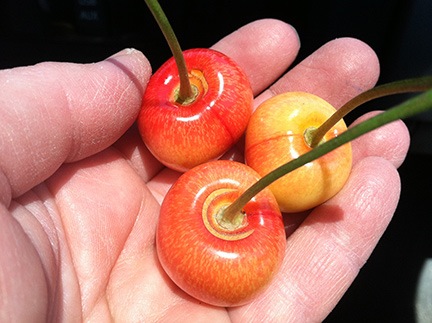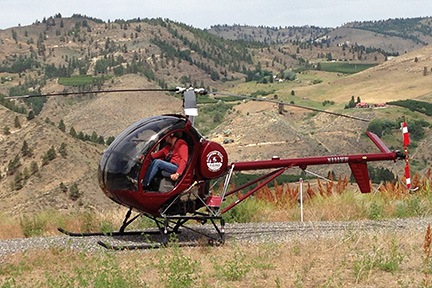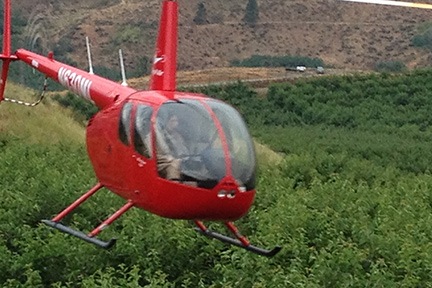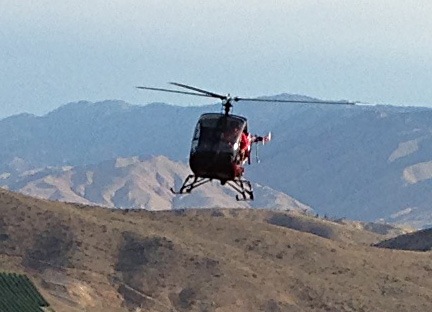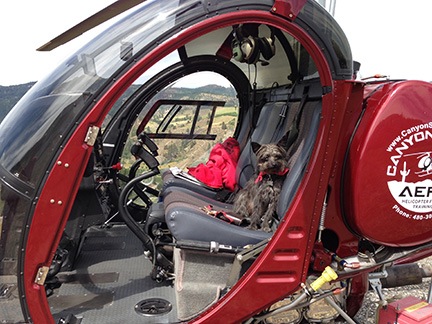Makes me wonder why I bother with the amateurs.
I had a great flight yesterday. A flight that should stand as a shining example of the kind of flying I love to do with the kind of professionals I like to work with. Let me tell you about it.
But first — because I can’t keep a short story short — some background.
Dealing with Amateurs
I feel the pain of professional photographers — folks who have invested thousands of dollars and years of their lives accumulating quality photography equipment, learning their craft, and practicing until they know how to make every shot count. These people are now competing with amateurs who buy DSLR cameras and call themselves “photographers.” These people use the “shotgun approach” to photography — they shoot dozens of images with the hopes that one or two of them will satisfy their client. They undercut the professionals in pricing because they simply don’t have as much invested in the business and, indeed, some might even have other jobs to support them. The professionals are losing jobs — and their livelihoods — because the amateurs are taking away their clients.
As a pilot providing aerial photography flights, I see this a lot. I get calls from photographers and videographers looking for a platform to get their aerial shots. If they don’t balk at my prices, they usually come in with a set time limit to minimize their flying costs. I can understand this — to a certain extent, anyway. Then they arrive for the shoot and immediately begin to show just how amateurish and unprofessional they are by:
- Bringing the wrong equipment. I’m talking about consumer quality cameras and lenses, telephoto and long zoom lenses, DSLRs for video, and bulky camera bags full of equipment they will not need and likely cannot access anyway during the flight.
- Ignoring my advice for seating. If they’re serious about getting good shots of a specific target, they should sit behind the pilot. That’s the only way the pilot can see what they see.
- Bringing two photographers with two different missions. Usually it’s a still photographer brought along on a video flight. That simply isn’t going to be as cost effective as they think if they take my advice and put the primary photographer behind me.
- Failing to communicate what they want or expect. I can’t fly the way they need me to if they don’t tell me what they want. They have a microphone next to their mouths. They need to use it. Without specific instructions, I can only assume that what I’m doing is what they want. They have no right to complain later if it isn’t.
- Making unreasonable demands. I’m talking about expecting to fill all seats in the helicopter when the extra weight would seriously affect performance. (I no longer do photo/video flights with more than two passengers on board. Period.) I’m talking about expecting the pilot to fly at top speed from target to target and then stop “on a dime” if a good shot comes into view along the way. I’m talking about expecting the pilot to hover low-level, fly close to obstacles such as wires, and perform other maneuvers that simply aren’t safe.
- Talking down to the pilot. I’ve seen this too many times. Amateurs with a bankroll have expensive equipment, no clue how to use it, and an attitude that makes me want to kick them in the teeth. They know it all — or think they do — and they feel a need to correct me every chance they get. I take guys like this just once, give them what they ask for, and never take them again. I don’t want clients like this.
I can think of at least two posts I’ve written that talk about the problems with specific amateurs: “Flying The 2010 Parker 425” and “Tips for Aerial Photographers.” You can get a better idea of the kind of crap I have to deal with by reading those.
Dealing with Professionals
But that’s not what this post is about. This post is about working with a seasoned professional who has lots of experience with aerial photography.
I started to get an idea of the level of professionalism I’d face before I even met the photographer. It was 7 AM and I needed to meet the client in Ephrata, WA at 8 AM. I was prepping the helicopter for the 20-minute flight. I wasn’t sure whether we’d have a single base of operations or if we’d be moving around. I needed to know whether I should remove doors before heading out.
The videographer, I’d been told, would be using a Tyler Minigyro. I’ve had experience with these before. They’re relatively flexible gyro-stabilized mounts that the videographer holds during flight. Because I wouldn’t be using my Moitek Mount, which needs to be installed in a specific seat, the videographer had three seats to choose from. Which door should I remove?
I called the client, coincidentally named Tyler. He was with the videographer. He asked the videographer what he thought. I heard his response through the phone: “The best seat is behind the pilot so she can see what I see.”
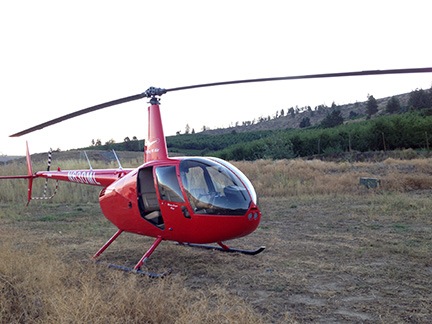
Here’s my helicopter yesterday morning, rigged for the photo flight with both back doors removed.
That was the exact right answer. “I like this guy already,” I told my client. I wound up removing both back doors in case lighting conditions made the videographer want to change seats. As it turned out, I didn’t need to do that and probably shouldn’t have — it caused additional wind to enter the aircraft during point-to-point travel. In all honesty, I probably could have left the doors on until meeting the client — and then stowed them in the client’s SUV.
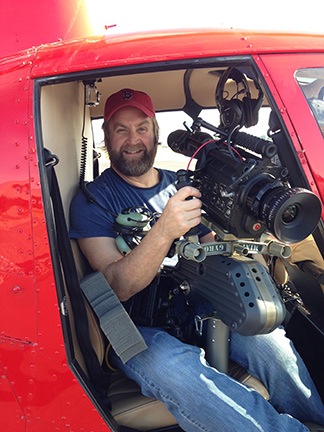
Here’s Jim, the videographer, almost ready to fly.
After picking up one client in Ephrata and flying down to Desert Aire in Mattawa, I met the other clients, including the videographer. The videographer was a burly bearded guy named Jim who was friendly and good-natured. He’d flown quite a bit with a pilot friend of mine in Idaho. He had a huge array of professional equipment, including the rented Tyler Minigyro, two enormous battery packs, an older RED camera with external hard disk, two lenses, a half dozen camera batteries, and a video monitor for the front seat observer. While this may seem like a lot of equipment, he only carried what he needed onboard; there were no extraneous camera bags and loose items.
After prepping most of the equipment, Jim told me he liked to start each shoot with a meeting to cover the expectations. Another sign of a professional. We chatted for a while about the targets we’d be shooting — mostly dams and recreational areas along the Columbia River — and the kinds of shots he was looking for. I told him what I needed from him — clear communication of what he wanted — and told him that I’d do what I could to get him in position for all of his shots. I assured him that the helicopter’s performance with just three people on board and 3/4 tanks fuel would be sufficient for most maneuvers.
We wound up taking off the front passenger door for the other client, who wanted to get some still images. (Of course.) Fortunately, for the duration of the flight I was not asked to put him into position to get his shots; he just shot what he wanted when he could get the right composition.
We lifted off and got to work around 9 AM, leaving Tyler behind to shoot on the ground. We immediately encountered some problems with the camera. First it was dropping frames and then it was locking up. Jim switched a battery in flight and we were able to get to work. His instructions to me were clear and easy to follow. I could tell that he’d flown with a lot of pilots before by the way he phrased his requests: “If you think it’s safe, can we…” It was obvious that he understood the limitations of helicopters and the potential danger of certain maneuvers. That comes from a lot of flying. (I’ve only had two other clients who clearly understood limitations: one had been a passenger in a helicopter for more hours than I’ve flown as a pilot and the other one is an airplane pilot.)
It wasn’t long before we ware working smoothly together, almost as if we’d worked together for a long time. He’d ask for maneuvers and I’d do my best to deliver them. He and the front seat passenger would ooh and aah when they saw a particularly nice shot in the viewfinder or monitor. He’d tell me when I was doing something right and when I wasn’t doing it quite the way he wanted. Communication was excellent — I don’t think I’ve ever worked with a better communicator.
The helicopter performed remarkably well, especially that morning when the temperatures were still cool. All flight sequences, including sideways “crabbing” flights at speeds up to 30 knots, were amazingly smooth. This was, in part, due to the fact that there was hardly a breath of wind. I couldn’t have asked for better flying conditions that morning, although I wish it was about 15 degrees cooler that afternoon.
We worked our way up the Columbia River, shooting the dams, boats on the river, cultural and recreational sites, bridges, cliffs, communities, and more. We refueled at Ellensburg and kept flying, always moving upriver. Time flew by. By the time we reached the Rock Island Dam just downriver from Wenatchee and Malaga, I was starting to feel fatigued and I think Jim was, too. After a quick stop at Quincy Airport to meet Tyler to swap out batteries, we got onto our last leg of the flight which took us to Euphrata and Moses Lake. We shot agricultural and industrial sites along the way.
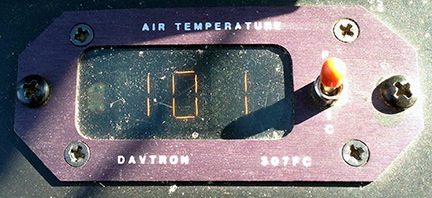
It’s been unseasonably warm this September in central Washington state.
By the time we landed at Moses Lake, I felt done — as in “stick a fork in me” done. The OAT gauge registered 101°F on the ramp. I was the only one with a door on the helicopter and was sweating up a storm by the time we touched down. Thank heaven for the folks at Million Aire; the girl who greeted us with a cart handed each of us an icy cold bottle of water that I really needed.
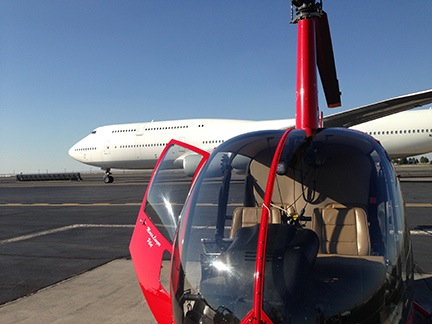
Jeez Louise! That’s a big plane!
By the time Tyler arrived and was escorted with the SUV out to the ramp, we’d unloaded most of the equipment from the helicopter. A Boeing 747 rolled in on the taxiway behind me and parked beside me; I don’t think I’ve ever been so close to a 747 on a ramp. (The damn thing is huge!) My clients stowed their equipment in the SUV and I fastened the door. I also let the FBO top off both tanks with fuel. Then my passenger and I were on our way back to Ephrata and, 15 minutes later, I was on my way home.
I got home around 4 PM. I’d spent 7.0 hours flying.
What Made this Great
I think it’s safe to say that this was one of the best aerial video gigs I’ve done in a long time. A few things made it so good:
- The experience and professionalism of the videographer. He knew his stuff, he knew what worked, he never asked for anything I couldn’t or wouldn’t deliver. He was reasonable and extremely communicative. He was a real pleasure to work with.
- The targets. The flight itself took us over some really nice scenery so point-to-point flying was a pleasure. The targets were interesting to see from the air and, in some cases, a bit challenging to shoot because of obstacles such as wires and cliff faces.
- The length of the flight. It was refreshing to fly with someone who was more interested in getting the shot than minimizing flight time. More than once, we’d redo a shot just to make sure we got what the client needed. We also approached targets from a variety of angles and altitudes. This meant that we were in the air a long time. And I’ll be honest with you: I’d rather do one 7-hour video flight with no pressure to finish within a certain time than seven 1-hour video flights that must be done within an hour.
I really liked this client and hope I get more work with them in the future. And I hope they feel the same about me.
I suspect they might.

